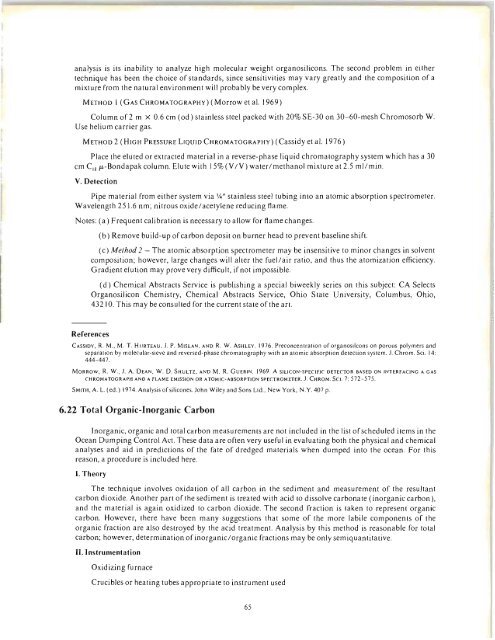Create successful ePaper yourself
Turn your PDF publications into a flip-book with our unique Google optimized e-Paper software.
analysis is its inability to analyze high molecular weight organosilicons. The second problem in either<br />
techniq ue has been the choice or standards, since sensitivities may vary greatly and the composition or a<br />
mixture rrom the natural environment will probably be very complex.<br />
METHOD I (GAS CHROMATOGRAPHY) (Morrow et al. 1969)<br />
Column or 2 m x 0.6 cm (od) stainless steel packed with 20% SE-30 on 30-60-mesh Chromosorb W.<br />
Use helium carrier gas.<br />
METHOD 2 (HIGH PRESSURE LIQUID CHROMATOGRAPHY) (Cassidy et al. 1976)<br />
Place the eluted or extracted material in a reverse-phase liquid chromatography system which has a 30<br />
cm C I8 fL-Bondapak column. Elute with 15% (V IV) water/methanol mixture at 2.5 ml/min.<br />
V. Detection<br />
Pipe material rrom either system via II.!" stainless steel tubing into an atomic absorption spectrometer.<br />
Wavelength 251.6 nm; nitrous oxide/acetylene reducing flame.<br />
Notes: (a) Freq uent calibration is necessary to allow ror flame changes.<br />
(b) Remove build-up orcarbon deposit on burner head to prevent baseline shirt.<br />
(c) Method 2 - The atomic absorption spectrometer may be insensitive to minor changes in solvent<br />
composition; however, large changes will alter the ruel/air ratio, and thus the atomization efficiency.<br />
Gradient elution may prove very difficu I t, ir not im possible.<br />
(d) Chemical Abstracts Service is publishing a special biweekly series on this subject: CA Selects<br />
Organosilicon Chemistry, Chemical Abstracts Service, Ohio State University, Columbus, Ohio,<br />
43210. This may be consulted ror the current state orthe art.<br />
References<br />
CASSIDY, R. M., M. T. HURTEAU. 1. P. MISLAN. AND R. W. ASHLEY. 1976. Preconcentration of organosilcons on porous polymers and<br />
separation by molecular-sieve and reversed-phase chromatography with an atomic absorption detection system. 1. Chromo Sci. 14:<br />
444-447.<br />
MORROW, R. W. , 1. A. DEAN , W. D. SHULTZ. AND M. R. GUERIN. 1969. A SILICON-SPECIFIC DETECTOR BASED ON INTERFACING A GAS<br />
CHROMATOGRAPH AND A FLAME EMISSION OR ATOMIC-ABSORPTION SPECTROMETER. 1. CHROM. SCI. 7: 572-575.<br />
SMITH, A. L. (ed.) 1974. Analysis of silicones. John Wiley and Sons LId., New York, N.Y. 407 p.<br />
6.22 Total Organic-Inorganic Carbon<br />
Inorganic, organic and total carbon measurements are not included in the list orscheduled items in the<br />
Ocean Dumping Control Act. These data are orten very userul in evaluating both the physical and chemical<br />
analyses and aid in predictions or the rate or dredged materials when dumped into the ocean. For this<br />
reason, a procedure is included here.<br />
I. Theory<br />
The technique involves oxidation or all carbon in the sediment and measurement or the resultant<br />
carbon dioxide. Another part or the sediment is treated with acid to dissolve carbonate (inorganic carbon),<br />
and the material is again oxidized to carbon dioxide. The second rraction is taken to represent organic<br />
carbon. However, there have been many suggestions that some or the more labile components or the<br />
organic rraction are also destroyed by the acid treatment. Analysis by this method is reasonable ror total<br />
carbon; however, determination orinorganic/organic rractions may be only semiquantitative.<br />
n. Instrumentation<br />
Oxidizing rurnace<br />
Crucibles or heating tubes appropriate to instrument used<br />
65

















